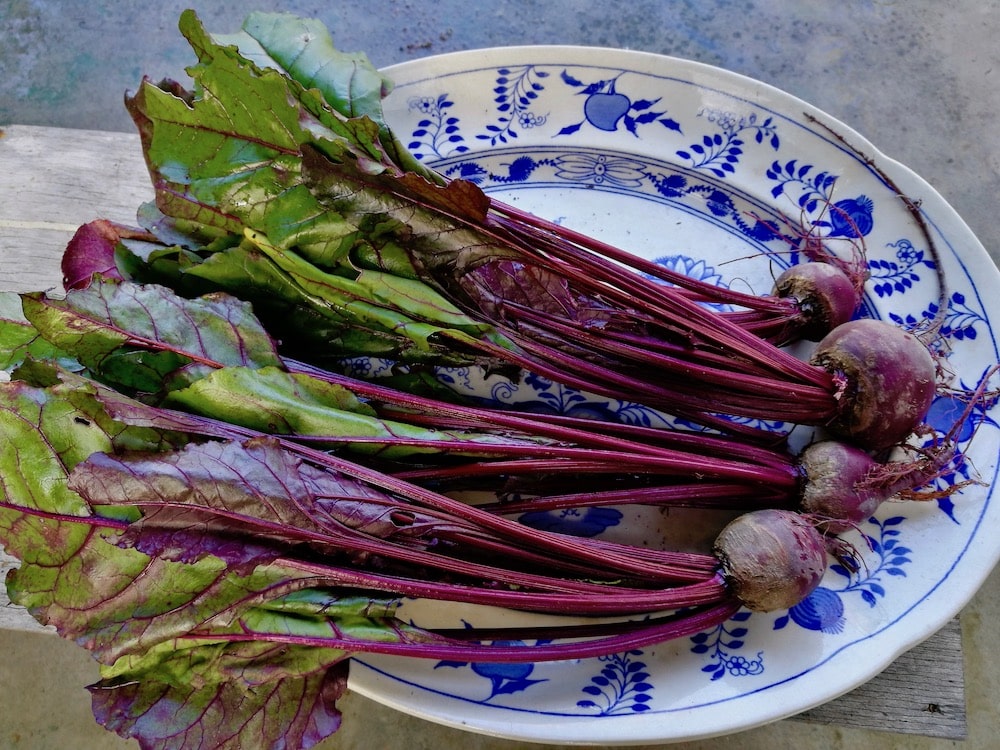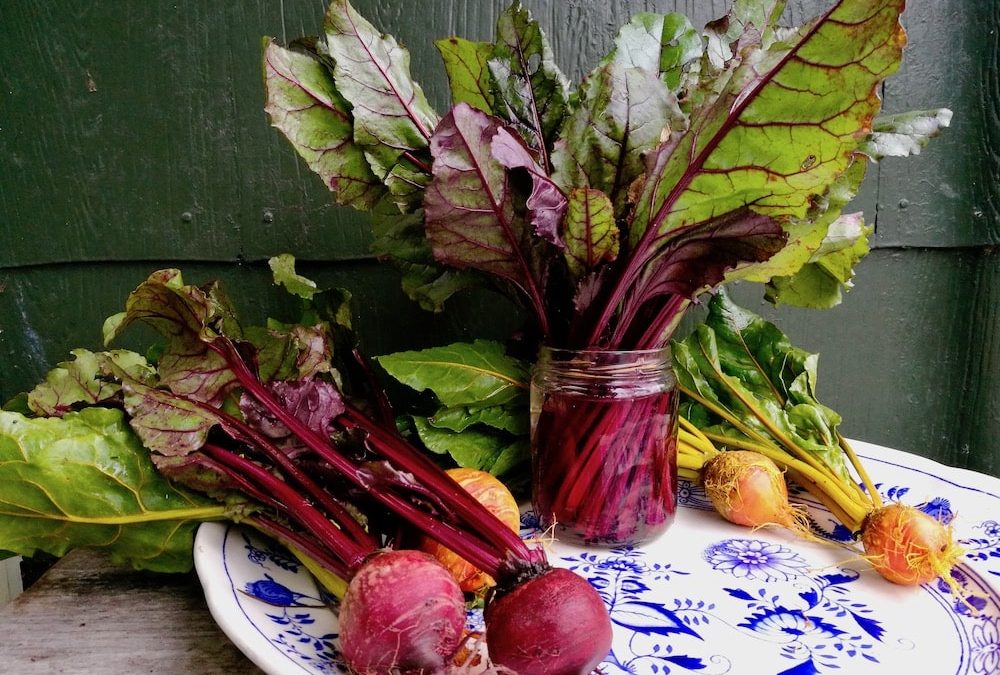We have a plethora of beetroot in our kitchen. Our regular vege box delivery includes beets every single week. They are most excellent beets: freshly picked, with huge fresh leaves still attached.
The other cooks in my household don’t tend to use beets, but they eat beets happily when I cook them.
Part of the challenge is that beets are not “fast food”. You have to think in advance, in order to make the best of beets. You can’t just throw them in a bowl and eat them, as they are.
But, once you’ve got your head around what to do with beets, they’re pretty straightforward.

Ancient beets
Beetroot, Beta vulgaris subsp. vulgaris ‘Conditiva’ Group, is a vegetable of which the root and leaves are both edible. It’s generally called beetroot in England and beets in North America. Both names are used interchangeably in New Zealand.
Beets were domesticated in the ancient Middle East. They were eaten by the ancient Egyptians, Greeks and Romans. Sugar beet, which is used to produce sugar, is another commonly grown Beta vulgaris variety.
Beetroot was not a feature of my childhood. I don’t think my mother, Sue, ever served it – not even canned beetroot.
But I’ve come to enjoy beets. I love the amazing purple colour, which some people unkindly call “lurid”. I love that beets can be used both cooked and raw (see my recipes below). I love the sweet-sour zing of beetroot in cider vinegar.
And it’s such a thrifty plant. You can make at least two completely different vegetable courses out of one bunch of beets.
Also, beets are in season pretty much all year round in the Waikato.
How to grow beets
I’ve grown beets successfully myself, which indicates how easy they are to grow. They’re not tricky like carrots. You can either plant the seeds directly into the ground, or plant seedlings.
Before you plant, prepare your soil with organic matter like compost and sheep pellets.
Plant beet seedlings 5 to 10cm apart.
Water regularly and keep the soil moist by mulching. That’s the main thing. Beets don’t like getting dried out.
Feed with liquid plant food – e.g. comfrey brew or the liquid from worm castings.
The beets will be ready to harvest in eight to twelve weeks.

Basic beetroot cooking
Many recipes involving beetroot specify that it should be pre-cooked. Beetroot can be either boiled or baked. Gently wash any dirt off the beets. Don’t peel before cooking.
To boil, place in a saucepan and cover with water. Simmer for up to 1 ½ hours, until tender but not soft. Check with a fork or skewer – younger beets may take less time to cook.
To bake, place beets in a baking dish covered with foil, with a little water in the bottom to stop them drying out. Bake for about three hours (less for small young beets) in a slow oven, 150 degC. Check after an hour to see how they’re going.
Cooked beetroot can be kept covered in the fridge. Hugh Fearnley-Whittingstall says beets keep better if they are not peeled until you are ready to eat them. When beets are cooked the skin should slip off easily.
Beet greens
Beet greens can be steamed or stir-fried, as you would cook spinach or silverbeet.
When they’re young and tender, beet greens can be added raw to salad.
Beet greens with garlic and mustard
Mustard adds an x-factor to the earthy taste of beet greens.
Ingredients
1 bunch beet greens
1 clove garlic (or more if you like)
Prepared Dijon mustard
Grated parmesan cheese (optional)
Method
Finely chop garlic.
Wash beet greens.
Finely slice the stalks. Slice or tear the leaves into pieces.
Add a splash of olive oil or a small knob of butter to a saucepan or a heavy frying pan.
Add garlic and cook for a few minutes on medium heat.
Now add the beet stalks. Cook, stirring, for two or three minutes. Then add the leaves and stir.
Cover the pan and leave to cook for 5 – 10 minutes or until the leaves have wilted down.
Stir in 1 tsp prepared Dijon mustard, or English mustard if that’s what you have.
Add a couple of tablespoons of grated parmesan cheese if you have some.
Grind over black pepper to taste.
Three recipes for cooked beetroot
Easy pickled beets
Place chunks of cooked beetroot in a bowl and add 2 tablespoons of apple cider vinegar, plus salt and pepper to taste.
NB there’s a great recipe for “real” pickled beets at the end of this post.
2. Scandinavian salad
This recipe comes from Lois Daish’s Dinner at Home, my favourite New Zealand cookbook.
Serves 2
Ingredients
1 or 2 beetroot, cooked and peeled
2 medium sized potatoes, boiled
1 small onion, thinly sliced into rings
About a cup of smoked fish pieces, with the bones picked out. I particularly love smoked mullet. Or you could use a can of tuna with the oil drained off.
½ cup broad beans, simmered until tender
2 hard boiled eggs, halved
Half a lettuce and a bunch of watercress, torn into bite sized pieces
Dressing
Mix together:
¾ cup olive oil
¼ cup white wine vinegar
2 cloves garlic, peeled and crushed
½ tsp wholegrain mustard
½ tsp sugar
½ tsp salt
Grinding of black pepper
Assembling the salad
Slice the potatoes and beets and place in a bowl with the onion rings.
Pour over enough dressing over to moisten everything.
Arrange the components of the salad on two individual plates, starting with a base of lettuce and watercress.
Sprinkle more dressing over the top.
3. Deep-fried beets
Hugh Fearnley-Whittingstall claims that thin slices of cooked beetroot are remarkably good deep-fried in batter. I have not tried this!
Three recipes for uncooked beetroot
Tray-roasted beets
A Jamie Oliver-style tray bake.
You’ll need a bunch of small uncooked beets.
Wash the beets thoroughly. You don’t need to peel them. Trim off the leaves – you’ll use these too.
Melt 2 tablespoons of lard or a splash of olive oil in a roasting pan. Add the beets and other veges, e.g. onions cut into wedges, baby leeks, garlic cloves, small carrots, etc. Shake so the oil or lard is spread around. Sprinkle with salt and pepper, and a squeeze of lemon juice.
Bake in a hot oven at 200 degC for 45 minutes, or until the beets are tender. Chop up the leaves and throw them on top for the last 10 minutes of cooking.
Red salad
I harvested this superb recipe, which uses raw beetroot, from Julie LeClerc.
Ingredients
Beetroot (raw)
Carrots
Sesame oil
Olive oil
1 lemon or 1 lime
2 tablespoons sesame seeds, toasted in a cast iron pan
1 spring onion, finely sliced
Method
Peel raw beetroot and carrots. I use approx 2 beetroot for every 3 carrots. But it depends on the size.
Grate them into a salad bowl. (NB this is messy. I do it in the sink.)
Add the sesame seeds and spring onion.
Dressing:
2 tsp sesame oil
2 tablespoons olive oil
juice of one lemon or lime (or more to taste)
½ tsp sugar
salt and pepper
finely grated zest of ½ a lemon or 1 lime
Add the dressing to the salad and mix well.
This salad is best made a couple of hours ahead, so the beets and carrots can marinate.
Optional extras:
Grated radish or daikon.
Sprinkle over 2 tablespoons chopped parsley or coriander
Sour beets
This traditional fermented pickle comes from Wild Fermentation, by Sandor Katz.
The first time I made this my household gobbled it up in two days. It was purple and sour and crunchy and wonderful.
Ingredients
2 kg beets
3 tablespoons sea salt
1 tablespoon caraway seeds
Method
Grate beets coarsely.
Place in a clean glass jar, sprinkling each layer with salt and caraway seeds as you go.
Place a weight on top of the grated beets. For a weight I use a smaller jar filled with water, with the lid screwed on.
Cover the jar of beets with a clean cloth and secure with a rubber band. This prevents insects and other critters from getting in.
Leave the jar on the kitchen bench.
Check after a couple of days. Taste the pickle. It will gradually get stronger over time.
The pickle will take anything from a few days to three or four weeks, depending on the time of year.
Wipe away any surface mould, rinse the weight and replace the cover.
There should always be a layer of liquid over the beets. In hot dry weather the liquid may evaporate off. If this starts happening, add some brine (made with 1 tablespoon salt and 1 cup of water).
If the pickle gets too dry it may turn soft and slimy. That happened with my second batch of beet pickle. Don’t let that put you off. Traditional ferments can be variable.


